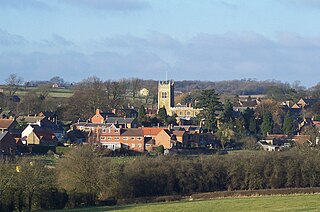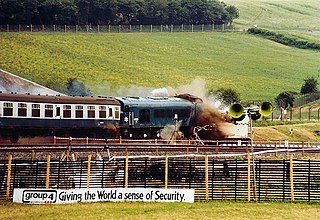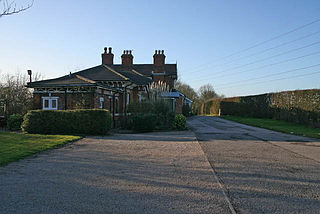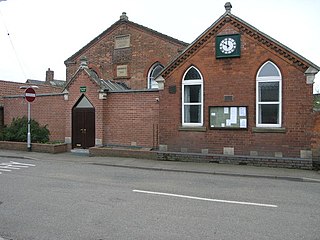
Melton Mowbray is a town in the Melton district in Leicestershire, England, 19 miles (31 km) north-east of Leicester, and 20 miles (32 km) south-east of Nottingham. It lies on the River Eye, known below Melton as the Wreake. The town had a population of 27,670 in 2019. The town is sometimes promoted as Britain's "Rural Capital of Food"; it is the home of the Melton Mowbray pork pie and is the location of one of six licensed makers of Stilton cheese.

Melton is a local government district with borough status in north-eastern Leicestershire, England. It is named after its only town, Melton Mowbray. The borough also includes numerous villages and surrounding rural areas. The north of the district includes part of the Vale of Belvoir. Melton is the least populous district of its type and the fourth least populous district in England overall.

Asfordby is a village and civil parish in the Melton district of Leicestershire, to the west of Melton Mowbray on the A6006 road. The village is north-east of Leicester.
Melton and Belvoir Rural District was a rural district of Leicestershire, England, from 1935 to 1974.

Melton Mowbray railway station serves the market town of Melton Mowbray in Leicestershire, England. It is owned by Network Rail and operated by East Midlands Railway, though CrossCountry operates most of the services as part of its Birmingham New Street to Stansted Airport route. The station is on the route of the Syston and Peterborough Railway, which is now part of the Birmingham to Peterborough Line. It has a ticket office, which is staffed part-time, a car park, and help points for times when no staff are present.

The A606 is an A road in England that starts in West Bridgford, on the outskirts of Nottingham, and heads southeastwards through Leicestershire and the towns of Melton Mowbray and Oakham, terminating at Stamford, Lincolnshire on the former Great North Road.

Scalford is a village and civil parish in the Melton borough of Leicestershire, England. It lies 4 miles (6.4 km) to the north of Melton Mowbray at the southern end of the Vale of Belvoir. In the 2011 census the parish had a population of 608.

Grimston was a railway station serving Saxelbye village in the English county of Leicestershire. It was opened on the Nottingham direct line of the Midland Railway between London and Nottingham via Corby.The station was formerly named Saxelbye, the name was changed after only 3 months to avoid confusion with Saxby, a few miles east of Melton Mowbray, on the Midland's other line between Leicester and Peterborough. The village of Grimston lies about one mile to the north west of the former Grimston station. The line still exists today as the Old Dalby Test Track.
The Old Dalby Test Track is a railway in the United Kingdom which is used for testing new designs of trains and railway infrastructure. It runs between Melton Mowbray, Leicestershire and Edwalton, on the course of the Midland Railway's route between Kettering and Nottingham which closed to passengers on 1 May 1967, and to goods in 1968. It is 13.5 miles (21.7 km) in length.

Widmerpool was a railway station serving Widmerpool in the English county of Nottinghamshire. It was situated on the Nottingham direct line of the Midland Railway between London and Nottingham via Corby.

Old Dalby railway station served Old Dalby in the English county of Leicestershire. It was opened on the Nottingham direct line of the Midland Railway between London and Nottingham, avoiding Leicester. The line still exists today as the Old Dalby Test Track.

Upper Broughton was a railway station serving Upper Broughton in the English county of Nottinghamshire. It was opened on the Nottingham direct line of the Midland Railway between London and Nottingham, avoiding Leicester. The line still exists today as the Old Dalby Test Track.

Plumtree railway station served Plumtree in the English county of Nottinghamshire, on the Nottingham direct line of the Midland Railway between London and Nottingham, avoiding Leicester. The station is now closed, although the line still exists today as the Old Dalby Test Track.

Nether Broughton is a village and former civil parish, now in the parish of Broughton and Old Dalby, in the Melton district, in Leicestershire, England. Broughton and Old Dalby's parish council is based in Nether Broughton. The village lies on the main A606 road between Melton Mowbray and Nottingham. The neighbouring village of Upper Broughton is on the same road, but within Nottinghamshire county. In 1931 the parish had a population of 345. On 1 April 1936 the parish was abolished to form "Broughton and Old Dalby".
Edwalton railway station served the village and district of Edwalton in the English county of Nottinghamshire. It was opened on the Midland Railway Melton direct route between London and Nottingham, avoiding Leicester.

Upper Broughton or Broughton-Sulney or Over-Broughton is a village and civil parish about seven miles north west of Melton Mowbray, in the Rushcliffe district of the county of Nottinghamshire, England. In 2011 the built-up area had a population of 327, the same as the parish. The parish touches Wymeswold, Hickling, Widmerpool, Broughton and Old Dalby and Willoughby on the Wolds. Upper Broughton is a conservation area that was designated in 1973 and is 16 hectares. It is near the boundary with Leicestershire, and Nether Broughton is across the county boundary.

Stanton-on-the-Wolds is a small village and a civil parish in Nottinghamshire, England. It is situated about 6 miles (10 km) south-east of Nottingham, just off the A606 Nottingham to Melton Mowbray road. It is bordered by several other villages, namely, Clipston-on-the-Wolds, Normanton-on-the-Wolds, Keyworth and Widmerpool.
The Nottingham direct line of the Midland Railway was a new route created in 1879 to relieve congestion on the established routes of the Midland Railway, in England. It consisted of two connecting lines that, together with part of an existing route, formed a new route from Nottingham to near Kettering. The line was used for Nottingham to London express passenger trains, and for heavy mineral and goods trains heading south. As well as shortening the transit a little, the new line had the effect of relieving congestion on the original main line through Leicester, that had become excessively congested.
























